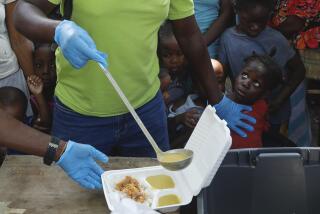Treatment of HIV-positive children still lags
- Share via
Treatment of HIV-positive children in the developing world grew by 28% in 2009, from 276,000 in 2008 to 365,000, but many children are still going untreated, the World Health Organization said Tuesday at the International AIDS Conference in Vienna. An estimated 400,000 infants acquire HIV each year, primarily at birth but also from breastfeeding, the agency said. Without early diagnosis and treatment, about one-third of them will die by their first birthday and about half by their second.
“With early diagnosis and prompt treatment, children have far better chances of surviving,” Dr. Gottfried Hirnschall, the new WHO director of HIV/AIDS, said in a statement.
Worldwide, an estimated 2.3 million children are currently infected and 730,000 urgently need treatment, experts said.
The problem is that diagnosis requires relatively expensive tests for the AIDS virus. The test also requires refrigeration, which is often not available in many rural communities. A major thrust of the United Nations effort against HIV in the near future will be to develop cheaper tests that can be used in resource-poor settings.
To reduce the number of new infections, WHO recommends that all HIV-positive pregnant women receive antiretroviral drugs during their pregnancy and that the drugs continue afterward if the women are breastfeeding. “This has been shown to give infants the best chance to be protected from HIV transmission in settings where breastfeeding is the best option,” the agency said in a statement.
“Virtual elimination of mother-to-child transmission of HIV by 2015 is possible,” Dr. Paul De Lay, deputy executive director of UNAIDS, said in a statement. “Relatively small investments can go a long way in saving mothers and babies.”
More to Read
Sign up for Essential California
The most important California stories and recommendations in your inbox every morning.
You may occasionally receive promotional content from the Los Angeles Times.










